In this article, we will understand an important specification of an electrical wire called its Gauge. The American Wire Gauge is one of the popular standards of wire sizes. We will learn the importance of the gauge of the with its current carrying capacity with the help of a Wire Gauge Chart. The wire gauge chart is also sometimes known as Wire Size Chart and it consists of important parameters of a wire such as its diameter in different measuring standards, maximum current, resistance and many other things.
Outline
ToggleImportance of a Wire Gauge Chart
Any electrical infrastructure, whether it is in homes, offices, shops or even large commercial building, consists of wires and cables. For a successful electrical installation, selection of the right wire size is very important. For instance, assume you are installing a new central air conditioner in your home and are trying to wire the AC unit. How do you select the wire size?
As the central AC is a powerful appliance, it draws significantly large amount of current. If the main wire that is responsible for supplying this current is not chosen properly, then the chances of fire or other damage are very high. This is where the wire gauge chart comes handy.
The Wire Size Chart lists out the ampacity of the wires as per its diameter. For the above situation, an AWG 6 wire should be sufficient as it is rated for a maximum current of 55A at 600C.
The American Wire Gauge (AWG)
Calculating the resistance of a particular length of wire for a certain wire diameter is highly impractical. This is where standards come into play. The American Wire Gauge (AWG) is one such standard that has been used since 1857 for measuring the diameter of an electrical conductor (usually round, solid and non-ferrous materials such as Copper and Aluminum).
The American Wire Gauge is also known as Brown and Sharpe Gauge (B & S Gauge) and it is a logarithmic stepped gauge system. Gauge size of a wire is an important parameter used in measuring the current carrying capacity of a wire, which is also known as its Ampacity.
AWG sets the diameter of a wire, which is often denoted as its Gauge. AWG is usually expressed in integers i.e., 1AWG, 2 AWG and so on. The larger the number, the smaller the diameter. The reason for this inverse order has to do with the 19th century manufacturing process of wires, where an electrical wire of a particular diameter is produced by passing a larger wire through a series of successive dies of decreasing size. After the wire passes through a die, it is wrapped around a draw block for several turns.
The draw blocks acts as a pulley and provides the required force to pull the wire through the die and thus reducing the size of the wire. The number of draws required to produce a wire of a particular diameter determines the Wire Gauge Size.
The following image shows a 6AWG wire entering the draw ‘a’. After each draw, the gauge of the wire is reduced by 1. So, after draw ‘a’, the wire gauge becomes 7AWG, which is then given to draw ‘b’. Finally, after the draw ‘d’, the wire comes as 10AWG.
The Wire Gauge (Measuring Device)
How can you measure the wire gauge while you are in the field? A simple device called the ‘Wire Gauge’ is designed specifically for this purpose. A Wire Gauge consists of a list of popular and commonly used AWG size of wires in a small circular disc. To determine the correct gauge size, remove the insulation around the main conductor and insert the wire in the slot (not the hole) of the wire gauge.
Wire Gauge Chart
AWG specifies the size of a wire using an integer called the Gauge. American Wire Gauge system assigns numbers from 0 to 44. In this list, 0AWG is having the largest diameter and 44AWG has the smallest diameter. For wire diameters larger than 0AWG, the AWG standard has specified three more gauges called 00 (2/0), 000 (3/0) and 0000 (4/0).
A simple wire gauge chart can be used to list out all the common AWG values along with their diameters, resistance, ampacity etc. The following tables shows the wire size chart with standard AWG values along with important parameters of the wires such as its diameter, cross-sectional area, resistance, ampacity frequency for skin depth and many more.
| AWG | Diameter | Cross-Sectional Area | Resistance
Ω / 1000 ft. (Ω / km) |
Ampacity
(A) |
Max. Freq for 100% Skin Depth (Hz) | ||||||
| mm | inch | mil | mm2 | cmil | Copper
200C (680F) |
Copper
750C (1670F) |
Aluminum
200C (680F) |
GND (Chassis) | Power Supply | ||
| 0000 (4/0) | 11.684 | 0.46 | 460 | 107.2 | 211600 | 0.049 (0.16) | 0.0596 (0.195) | 0.0804 (0.263) | 380 | 302 | 125 |
| 000 (3/0) | 10.404 | 0.4096 | 409.6 | 85 | 167800 | 0.0618 (0.2) | 0.0752 (0.246) | 0.101 (0.33) | 328 | 239 | 160 |
| 00 (2/0) | 9.26 | 0.3648 | 364.8 | 67.4 | 133100 | 0.078 (0.26) | 0.0948 (0.31) | 0.128 (0.42) | 283 | 190 | 200 |
| 0 (1/0) | 8.25 | 0.3249 | 324.9 | 53.5 | 105600 | 0.0983 (0.32) | 0.1195 (0.392) | 0.161 (0.53) | 245 | 150 | 250 |
| 1 | 7.35 | 0.2893 | 289.3 | 42.4 | 83690 | 0.1239 (0.406) | 0.151 (0.49) | 0.203 (0.66) | 211 | 119 | 325 |
| 2 | 6.54 | 0.2576 | 257.6 | 33.6 | 66360 | 0.1563 (0.512) | 0.19 (0.62) | 0.526 (0.84) | 181 | 94 | 410 |
| 3 | 5.82 | 0.2294 | 229.4 | 26.7 | 52620 | 0.197 (0.646) | 0.24 (0.79) | 0.323 (1.06) | 158 | 75 | 500 |
| 4 | 5.19 | 0.2043 | 204.3 | 21.1 | 41740 | 0.2485 (0.815) | 0.302 (0.99) | 0.408 (1.34) | 135 | 60 | 650 |
| 5 | 4.62 | 0.1819 | 181.9 | 16.8 | 33090 | 0.3133 (1.027) | 0.381 (1.25) | 0.514 (1.68) | 118 | 47 | 810 |
| 6 | 4.11 | 0.162 | 162 | 13.3 | 26240 | 0.395 (1.29) | 0.481 (1.58) | 0.648 (2.12) | 101 | 37 | 1100 |
| 7 | 3.67 | 0.1443 | 144.3 | 10.6 | 20820 | 0.498 (1.63) | 0.606 (1.99) | 0.817 (2.68) | 89 | 30 | 1300 |
| 8 | 3.26 | 0.1285 | 128.5 | 8.37 | 16510 | 0.628 (2.06) | 0.764 (2.5) | 1.03 (3.38) | 73 | 24 | 1650 |
| 9 | 2.91 | 0.1144 | 114.4 | 6.63 | 13090 | 0.792 (2.6) | 0.963 (3.16) | 1.30 (4.26) | 64 | 19 | 2050 |
| 10 | 2.59 | 0.1019 | 101.9 | 5.26 | 10380 | 0.999 (3.27) | 1.215 (3.98) | 1.64 (5.38) | 55 | 15 | 2600 |
| 11 | 2.30 | 0.0907 | 90.7 | 4.17 | 8230 | 1.26 (4.13) | 1.532 (5.02) | 2.07 (6.78) | 47 | 12 | 3200 |
| 12 | 2.05 | 0.0808 | 80.8 | 3.31 | 6530 | 1.588 (5.2) | 1.931 (6.33) | 2.61 (8.56) | 41 | 9.3 | 4150 |
| 13 | 1.83 | 0.072 | 72 | 2.63 | 5180 | 2.003 (6.57) | 2.44 (8) | 3.29 (10.8) | 35 | 7.4 | 5300 |
| 14 | 1.63 | 0.0641 | 64.1 | 2.08 | 4110 | 2.525 (8.28) | 3.07 (10.1) | 4.14 (13.6) | 32 | 5.9 | 6700 |
| 15 | 1.45 | 0.0571 | 57.1 | 1.65 | 3260 | 3.184 (10.43) | 3.98 (12.7) | 5.22 (17.1) | 28 | 4.7 | 8250 |
| 16 | 1.29 | 0.0508 | 50.8 | 1.31 | 2580 | 4.016 (13.16) | 4.88 (16) | 6.59 (21.6) | 22 | 3.7 | 11k |
| 17 | 1.15 | 0.0453 | 45.3 | 1.04 | 2050 | 5.06 (16.6) | 6.16 (20.2) | 8.31 (27.2) | 19 | 2.9 | 13k |
| 18 | 1.02 | 0.0403 | 40.3 | 0.823 | 1620 | 6.39 (20.9) | 7.77 (25.5) | 10.5 (34.4) | 16 | 2.3 | 17k |
| 19 | 0.904 | 0.0359 | 35.9 | 0.653 | 1390 | 8.05 (26.4) | 9.79 (32.1) | 13.2 (43.3) | 14 | 1.8 | 21k |
| 20 | 0.813 | 0.032 | 32 | 0.519 | 1020 | 10.15 (33.3) | 12.35 (40.5) | 16.7 (54.7) | 11 | 1.5 | 27k |
| 21 | 0.724 | 0.0285 | 28.5 | 0.412 | 812 | 12.8 (42) | 15.6 (51.1) | 21.0 (68.8) | 9 | 1.2 | 33k |
| 22 | 0.643 | 0.0253 | 25.3 | 0.324 | 640 | 16.1 (53) | 19.6 (64.2) | 26.5 (86.9) | 7 | 0.92 | 42k |
| 23 | 0.574 | 0.0226 | 22.6 | 0.259 | 511 | 20.4 (67) | 24.8 (81.3) | 33.4 (109) | 4.7 | 0.729 | 53k |
| 24 | 0.511 | 0.0201 | 20.1 | 0.205 | 404 | 25.7 (84) | 31.2 (102) | 42.1 (138) | 3.5 | 0.577 | 68k |
| 25 | 0.455 | 0.0179 | 17.9 | 0.162 | 320 | 32.4 (106) | 39.4 (129) | 53.1 (174) | 2.7 | 0.457 | 85k |
| 26 | 0.404 | 0.0159 | 15.9 | 0.128 | 253 | 40.8 (134) | 49.6 (163) | 67.0 (220) | 2.2 | 0.361 | 107k |
| 27 | 0.361 | 0.0142 | 14.2 | 0.102 | 202 | 51.5 (169) | 62.6 (205) | 84.4 (277) | 1.7 | 0.288 | 130k |
| 28 | 0.320 | 0.0126 | 12.6 | 0.0804 | 159 | 64.9 (213) | 78.9 (259) | 106.0 (347) | 1.4 | 0.226 | 170k |
| 29 | 0.287 | 0.0113 | 11.3 | 0.0647 | 128 | 81.8 (268) | 99.5 (326) | 134.0 (439) | 1.2 | 0.182 | 210k |
| 30 | 0.254 | 0.01 | 10 | 0.0507 | 100 | 103.2 (338) | 125.5 (411) | 169.0 (554) | 0.86 | 0.142 | 270k |
| 31 | 0.226 | 0.0089 | 8.9 | 0.0401 | 79.2 | 130.1 (426) | 158.2 (519) | 213.0 (698) | 0.7 | 0.113 | 340k |
| 32 | 0.203 | 0.008 | 8 | 0.0324 | 64 | 164.1 (538) | 199.5 (654) | 269.0 (882) | 0.53 | 0.091 | 430k |
| 33 | 0.180 | 0.0071 | 7.1 | 0.0255 | 50.4 | 207 (680) | 252 (826) | 339 (1110) | 0.43 | 0.0720 | 540k |
| 34 | 0.160 | 0.0063 | 6.3 | 0.0201 | 39.7 | 261 (860) | 317 (1040) | 428 (1400) | 0.33 | 0.056 | 690k |
| 35 | 0.142 | 0.0056 | 5.6 | 0.0159 | 31.4 | 329 (1080) | 400 (1310) | 540 (1770) | 0.27 | 0.044 | 870k |
| 36 | 0.127 | 0.005 | 5 | 0.0127 | 25 | 415 (1360) | 505 (1650) | 681 (2230) | 0.21 | 0.035 | 1100k |
| 37 | 0.114 | 0.0045 | 4.5 | 0.0103 | 20.2 | 523 (1710) | 636 (2080) | 858 (2810) | 0.17 | 0.0289 | 1350k |
| 38 | 0.102 | 0.004 | 4 | 0.00811 | 16 | 660 (2160) | 802 (263) | 1080 (3540) | 0.13 | 0.0228 | 1750k |
| 39 | 0.089 | 0.0035 | 3.5 | 0.00621 | 12.2 | 832 (2730) | 1012 (3320) | 1360 (4460) | 0.11 | 0.0175 | 2250k |
| 40 | 0.0787 | 0.0031 | 3.1 | 0.00487 | 9.61 | 1049 (3440) | 1276 (4180) | 1720 (5640) | 0.09 | 0.0137 | 2900k |
| 41 | 0.0711 | 0.0028 | 2.8 | 0.00397 | 7.84 | ||||||
| 42 | 0.0635 | 0.0025 | 2.5 | 0.00317 | 6.25 | ||||||
| 43 | 0.0559 | 0.0022 | 2.2 | 0.00245 | 4.84 | ||||||
| 44 | 0.0508 | 0.002 | 2 | 0.00203 | 4 | ||||||
How to Calculate the Diameter of a Wire from its AWG?
There is a simple formula to determine the diameter of a wire for a given AWG. The following is the formula to calculate the diameter of an AWG wire in mm.
For example, the diameter of 10AWG wire in mm is
For 0000 (4/0), 000 (3/0), 00 (2/0) and 0 (1/0), the AWG numbers are -3, -2, -1 and 0 respectively.
Electrical Wires and Cables
When we talk about electrical conductors, the first thing that comes to mind is Copper. Solid Copper Wires are one of the best conductors of electricity and are most commonly used for carrying electricity. Apart from Copper, Aluminum and Copper coated Aluminum are also used as electrical wires.
Due to the concept of Skin effect, the current travels on the surface of the conductor. As a result, some sort of protective shielding called as Insulation is added on top of the wires to prevent electric shocks and fire accidents.
The type of insulation differs from the type of conductor i.e., Copper, Aluminum and Copper coated Aluminum, all have their own insulation requirements. All wires have insulation usually made up of plastic vinyl or rubber (not used anymore).
Insulation layer is color coded, which we call as Electric Wiring Color Codes. These color codes are an important specification and are used to determine hot, neutral or earth (grounding) wire. In the United States, Black is used for hot and white is used for neutral in case of a single-phase supply.
If a group of wires are enclosed in a rubber, plastic vinyl or metal sheath, then it is called a cable. The sheath layer protects the wires from damage.
It is very important to select the proper wire gauge with enough amperage. If a wire is used for a higher amperage than it is rated for, then it gets very hot and can even start a fire. Hence, the Wire Gauge Chart mentioned above is an important tool for checking the amperage of a wire.
Common Wire Sizes and their Applications
From the above wire gauge chart, it is clear that higher gauge wires have lower ampacity and vice-versa. So, a wire used for lighting circuits will be a light-duty higher gauge wire whereas wires used for air conditioners and other power intensive appliances will be heavy-duty lower gauge wires.
The following image shows some of the commonly used wire gauges along with their applications.
Conclusion
An introductory article on American Wire Gauge (AWG), wire gauge chart with ampacity values corresponding to the wire gauge along with other information such as diameter, cross-sectional area, resistance etc.
You learned the importance of following a proper standard such as AWG to select the right gauge wire. The wire size chart with some commonly used wires sizes in daily applications.

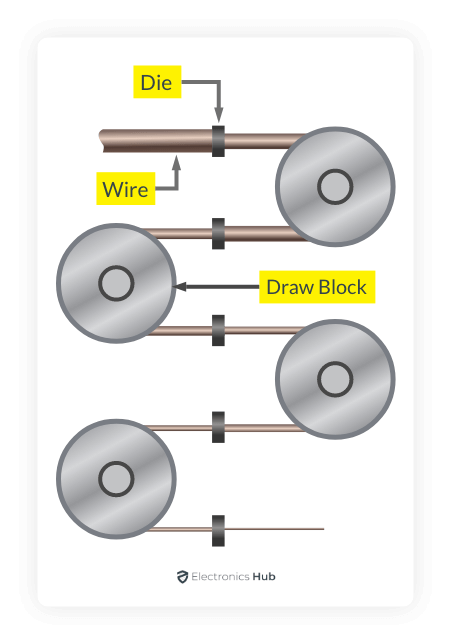
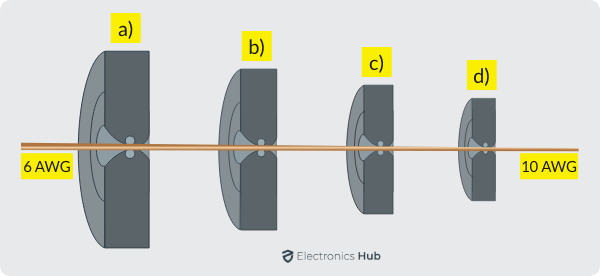
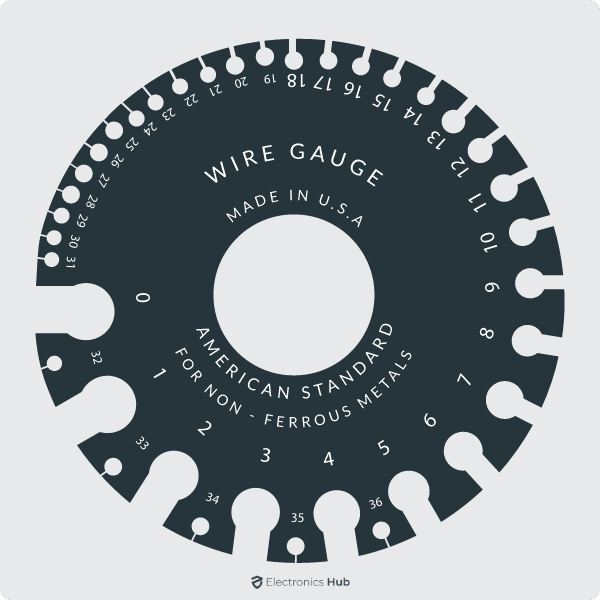
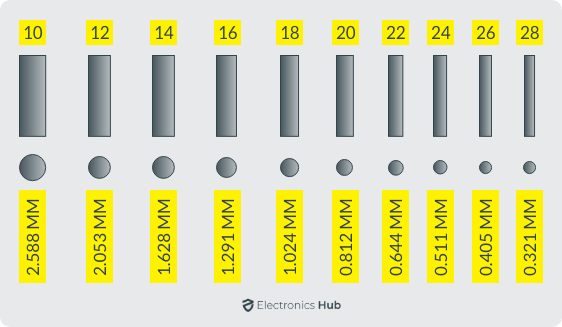
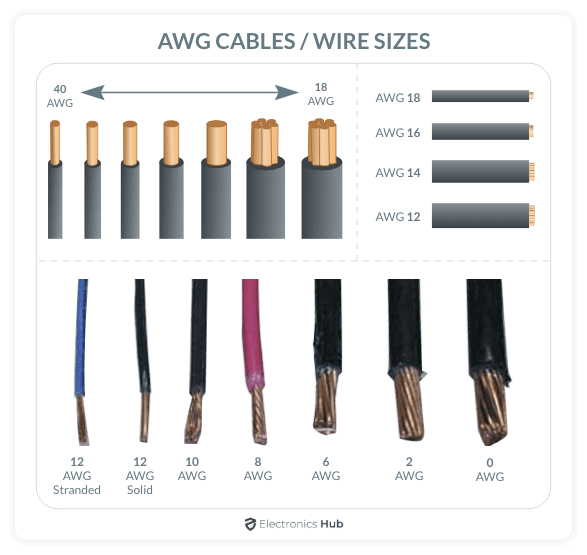
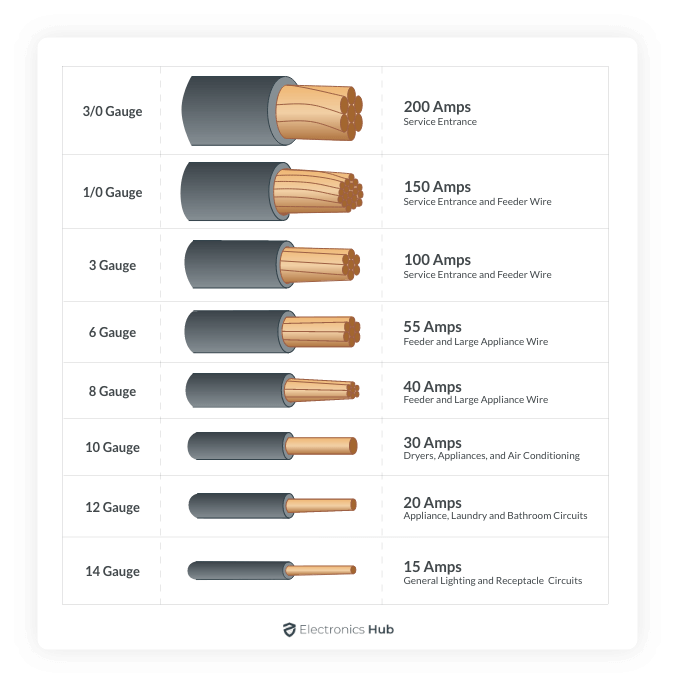

2 Responses
Thanks for giving us the opportunity and understanding of wires gauge and diameters.
But please explained the circulation in more details
how much price swg for 1 pice and where abailable